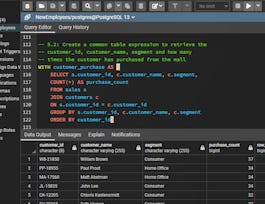This is the second course in Java Database Connectivity (JDBC) and builds upon the core principals and techniques in the JDBC 1 course. It utilizes PreparedStatements, highlighting their advantages over JDBC Statements. It will also introduce utilizing Stored Procedures on the database server itself to encapsulate complex SQL and PLSQL logic. The Course also introduces the idea of querying the database meta data such as table structures and how to cope with different SQL syntax for different Jdbc complaint databases via the JDBC escape syntax.

Give your career the gift of Coursera Plus with $160 off, billed annually. Save today.


Prepared Statements and Stored Procedures
This course is part of Java Database Connectivity Specialization

Instructor: Marnie Knue
1,785 already enrolled
Included with 
Recommended experience
Skills you'll gain
Details to know

Add to your LinkedIn profile
4 assignments
See how employees at top companies are mastering in-demand skills

Build your subject-matter expertise
- Learn new concepts from industry experts
- Gain a foundational understanding of a subject or tool
- Develop job-relevant skills with hands-on projects
- Earn a shareable career certificate


Earn a career certificate
Add this credential to your LinkedIn profile, resume, or CV
Share it on social media and in your performance review

There are 2 modules in this course
In this module the student will learn how PreparedStatement objects, unlike a JDBC Statement object, it is given a SQL statement when it is created and is sent to the DBMS right away, where it is compiled. It will also introduce the concept of Meta data enabling the programmer to gain an understanding of the database Schema the JDBC code is interacting with
What's included
5 videos1 reading2 assignments1 discussion prompt2 ungraded labs1 plugin
In this module the student will learn about Stored Procedures to encapsulate a set of operations or queries that cna be executed on a database server. The student will also learn about the techniques on dealing with the differences in the way different DBMS vendors implement SQL. This is called escape syntax. which signals that the JDBC driver, provided by a particular JDBC vendor can converts it into code that its particular database can understand
What's included
4 videos1 reading2 assignments1 discussion prompt2 ungraded labs1 plugin
Instructor

Offered by
Recommended if you're interested in Software Development

LearnKartS

Coursera Project Network
Why people choose Coursera for their career




New to Software Development? Start here.

Open new doors with Coursera Plus
Unlimited access to 7,000+ world-class courses, hands-on projects, and job-ready certificate programs - all included in your subscription
Advance your career with an online degree
Earn a degree from world-class universities - 100% online
Join over 3,400 global companies that choose Coursera for Business
Upskill your employees to excel in the digital economy
Frequently asked questions
Access to lectures and assignments depends on your type of enrollment. If you take a course in audit mode, you will be able to see most course materials for free. To access graded assignments and to earn a Certificate, you will need to purchase the Certificate experience, during or after your audit. If you don't see the audit option:
The course may not offer an audit option. You can try a Free Trial instead, or apply for Financial Aid.
The course may offer 'Full Course, No Certificate' instead. This option lets you see all course materials, submit required assessments, and get a final grade. This also means that you will not be able to purchase a Certificate experience.
When you enroll in the course, you get access to all of the courses in the Specialization, and you earn a certificate when you complete the work. Your electronic Certificate will be added to your Accomplishments page - from there, you can print your Certificate or add it to your LinkedIn profile. If you only want to read and view the course content, you can audit the course for free.
If you subscribed, you get a 7-day free trial during which you can cancel at no penalty. After that, we don’t give refunds, but you can cancel your subscription at any time. See our full refund policy.



